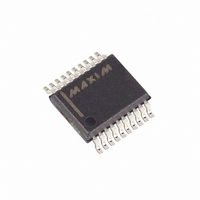MAX192BEAP+ Maxim Integrated Products, MAX192BEAP+ Datasheet - Page 8

MAX192BEAP+
Manufacturer Part Number
MAX192BEAP+
Description
IC ADC 10BIT SERIAL 20-SSOP
Manufacturer
Maxim Integrated Products
Type
Data Acquisition System (DAS), ADCr
Datasheet
1.MAX192BEWP.pdf
(24 pages)
Specifications of MAX192BEAP+
Resolution (bits)
10 b
Sampling Rate (per Second)
133k
Data Interface
Serial
Voltage Supply Source
Single Supply
Voltage - Supply
±5V
Operating Temperature
-40°C ~ 85°C
Mounting Type
Surface Mount
Package / Case
20-SSOP
Package
20SSOP
Resolution
10 Bit
Sampling Rate
133 KSPS
Architecture
SAR
Number Of Adcs
1
Number Of Analog Inputs
8|4
Digital Interface Type
Serial (4-Wire, SPI, QSPI, Microwire)
Input Type
Voltage
Polarity Of Input Voltage
Unipolar|Bipolar
Conversion Rate
133 KSPs
Interface Type
Serial
Voltage Reference
Internal 4.096 V or External
Supply Voltage (max)
5 V
Maximum Power Dissipation
640 mW
Maximum Operating Temperature
+ 85 C
Mounting Style
SMD/SMT
Minimum Operating Temperature
- 40 C
Lead Free Status / RoHS Status
Lead free / RoHS Compliant
The T/H enters its tracking mode on the falling clock
edge after the fifth bit of the 8-bit control word has been
shifted in. The T/H enters its hold mode on the falling
clock edge after the eighth bit of the control word has
been shifted in. If the converter is set up for single-ended
inputs, IN- is connected to AGND, and the converter
samples the “+” input. If the converter is set up for differ-
ential inputs, IN- connects to the “-” input, and the differ-
ence of IN+ - IN- is sampled. At the end of the conver-
sion, the positive input connects back to IN+, and
C
The time required for the T/H to acquire an input signal is
a function of how quickly its input capacitance is charged.
If the input signal’s source impedance is high, the acquisi-
tion time lengthens and more time must be allowed
between conversions. Acquisition time is calculated by:
where R
input signal, and tAZ is never less than 1.5µs. Note that
source impedances below 5kW do not significantly affect
the AC performance of the ADC. Higher source imped-
ances can be used if an input capacitor is connected to
the analog inputs, as shown in Figure 5. Note that the
input capacitor forms an RC filter with the input source
impedance, limiting the ADC’s signal bandwidth.
The ADC’s input tracking circuitry has a 4.5MHz
small-signal bandwidth, so it is possible to digitize
high-speed transient events and measure periodic sig-
nals with bandwidths exceeding the ADC’s sampling
rate by using undersampling techniques. To avoid
high-frequency signals being aliased into the frequency
Low-Power, 8-Channel,
Serial 10-Bit ADC
Table 1. Channel Selection in Single-Ended Mode
8
SEL2
HOLD
0
1
0
1
0
1
0
1
_______________________________________________________________________________________
charges to the input signal.
IN
SEL1
= 5kΩ, R
0
0
0
0
1
1
1
1
t
AZ
= 9 (R
SEL0
S
0
0
1
1
0
0
1
1
= the source impedance of the
S
+ R
CH0
IN
+
) 16pF
Input Bandwidth
CH1
Track/Hold
+
CH2
+
band of interest, anti-alias filtering is recommended.
See the data sheets for the MAX291–MAX297 filters.
Internal protection diodes, which clamp the analog
input to V
swing from AGND - 0.3V to V
age. However, for accurate conversions near full scale,
the inputs must not exceed V
be lower than AGND by 50mV.
If the analog input exceeds 50mV beyond the sup-
plies, do not forward bias the protection diodes of
off channels over 2mA.
The MAX192 can be configured for differential (unipolar
or bipolar) or single-ended (unipolar only) inputs, as
selected by bits 2 and 3 of the control byte (Table 3).
In the single-ended mode, set the UNI/BIP bit to unipolar.
In this mode, analog inputs are internally referenced to
AGND, with a full-scale input range from 0V to V
In differential mode, both unipolar and bipolar settings
can be used. Choosing unipolar mode sets the differen-
tial input range at 0V to V
(code zero) when a negative differential input voltage is
applied. Bipolar mode sets the differential input range to
±V
mon-mode input range includes both supply rails. Refer
to Tables 4a and 4b for input voltage ranges.
To evaluate the analog performance of the MAX192
quickly, use Figure 5’s circuit. The MAX192 requires a
control byte to be written to DIN before each
conversion. Tying DIN to +5V feeds in control bytes of
CH3
+
Analog Input Range and Input Protection
REF
(SGL/DIF = 1)
/ 2. Note that in this differential mode, the com-
DD
CH4
+
and AGND, allow the channel input pins to
CH5
+
REF
. The output code is invalid
DD
CH6
DD
+
by more than 50mV, or
+ 0.3V without dam-
CH7
Quick Look
+
REF
AGND
.
–
–
–
–
–
–
–
–











